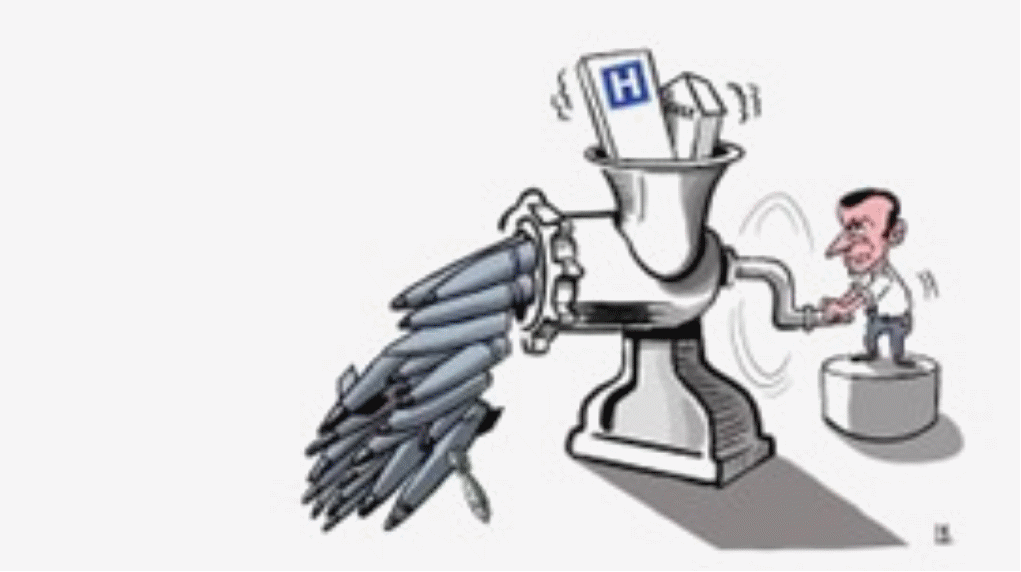 From welfare to warfare: military Keynesianism
From welfare to warfare: military KeynesianismBy Michael Roberts
Warmongering has reached fever pitch in Europe. It all started with the US under Trump deciding that paying for the military ‘protection’ of European capitals from potential enemies was not worth it. Trump wants to stop the US paying for the bulk of the financing of NATO and providing its military might and he wants to end the Ukraine-Russia conflict so he can concentrate US imperialist strategy on the ‘Western hemisphere’ and the Pacific, with the aim of ‘containing’ and weakening China’s economic rise.
Trump’s strategy has panicked the European ruling elites. They are suddenly concerned that Ukraine will lose to the Russian forces and before long Putin will be at the borders of Germany or as UK premier Keir Starmer and a former head of MI5 both claim, “in British streets”.
Europe’s military using the current situation to argue for rearmament
Whatever the validity of this supposed danger, the opportunity has been created for Europe’s military and secret services to ‘up the ante’ and call for an end to the so-called ‘peace dividend’ that began after the fall of the dreaded Soviet Union and now begin the process of rearmament. The EU Foreign Policy Chief Kaja Kallas spelt out the EU’s foreign policy as she saw it: “If together we are not able to put enough pressure on Moscow, then how can we claim that we can defeat China?”
Several arguments are offered for rearming European capitalism. Bronwen Maddox, director of Chatham House, the international relations ‘think-tank’, which mainly presents the views of the British military state, kicked it off with the claim that “spending on ‘defence’ “is the greatest public benefit of all” because it is necessary for the survival of ‘democracy’ against authoritarian forces. But there is a price to be paid for defending democracy: “the UK may have to borrow more to pay for the defence spending it so urgently needs. In the next year and beyond, politicians will have to brace themselves to reclaim money through cuts to sickness benefits, pensions and healthcare.” She went on: “If it took decades to build up this spending, it may take decades to reverse it,” so Britain needs to get on with it. “Starmer will soon have to name a date by which the UK will meet 2.5 per cent of GDP on military spending — and there is already a chorus arguing that this figure needs to be higher. In the end, politicians will have to persuade voters to surrender some of their benefits to pay for defence.”
Martin Wolf, the liberal Keynesian economic guru of the Financial Times, launched in: “spending on defence will need to rise substantially. Note that it was 5 per cent of UK GDP, or more, in the 1970s and 1980s. It may not need to be at those levels in the long term: modern Russia is not the Soviet Union. Yet it may need to be as high as that during the build-up, especially if the US does withdraw.”
Wolf argues that higher defence spending is an ‘economic opportunity’
How to pay for this? “If defence spending is to be permanently higher, taxes must rise, unless the government can find sufficient spending cuts, which is doubtful.” But don’t worry, spending on tanks, troops and missiles is actually beneficial to an economy, says Wolf. “The UK can also realistically expect economic returns on its defence investments. Historically, wars have been the mother of innovation.” He then cites the wonderful examples of the gains that Israel and Ukraine have made from their wars: “Israel’s “start up economy” began in its army. The Ukrainians now have revolutionised drone warfare.” He does not mention the human cost involved in innovation by war. Wolf moves on: “The crucial point, however, is that the need to spend significantly more on defence should be viewed as more than just a necessity and also more than just a cost, though both are true. If done in the right way, it is also an economic opportunity.” So war is the way out of economic stagnation.
Wolf shouts that Britain needs to get on with it: “If the US is no longer a proponent and defender of liberal democracy, the only force potentially strong enough to fill the gap is Europe. If Europeans are to succeed with this heavy task, they must begin by securing their home. Their ability to do so will depend in turn on resources, time, will and cohesion ….. Undoubtedly, Europe can substantially increase its spending on defence.” Wolf argued that we must defend the vaunted “European values” of personal freedom and liberal democracy. “To do so will be economically costly and even dangerous but necessary… because “Europe has ‘fifth columns’ almost everywhere.” He concluded that “If Europe does not mobilise quickly in its own defence, liberal democracy might founder altogether. Today feels a bit like the 1930s. This time, alas, the US looks to be on the wrong side.”
Claim that the welfare state should be attacked to fund warfare
‘Progressive conservative’, FT columnist Janan Ganesh spelt it out baldly: “Europe must trim its welfare state to build a warfare state. There is no way of defending the continent without cuts to social spending.” He made it clear that the gains working people made after the end of WW2 but were gradually whittled away in the last 40 years must now be totally dispensed with. “The mission now is to defend Europe’s lives. How, if not through a smaller welfare state, is a better-armed continent to be funded?” The golden age of the post-war welfare state is not possible any more. “Anyone under 80 who has spent their life in Europe can be excused for regarding a giant (sic – MR) welfare state as the natural way of things. In truth, it was the product of strange historical circumstances, which prevailed in the second half of the 20th century and no longer do.”
Yes, correct, the gains for working people in the golden age were the exception from the norm in capitalism (‘strange historical circumstances’). But now “pension and healthcare liabilities were going to be hard enough for the working population to meet even before the current defence shock…..Governments will have to be stingier with the old. Or, if that is unthinkable given their voting weight, the blade will have to fall on more productive areas of spending … Either way, the welfare state as we have known it must retreat somewhat: not enough that we will no longer call it by that name, but enough to hurt.” Ganesh, the true conservative, sees rearmament as an opportunity for capital to make the necessary reductions in welfare and public services. “Spending cuts are easier to sell on behalf of defence than on behalf of a generalised notion of efficiency…. Still, that isn’t the purpose of defence, and politicians must insist on this point. The purpose is survival.” So so-called ‘liberal capitalism’ needs to survive and that means cutting living standards for the poorest and spending money on going to war. From welfare state to warfare state.
Poland’s Prime minister Donald Tusk took the warmongering up another notch. He said that Poland “must reach for the most modern possibilities, also related to nuclear weapons and modern unconventional weapons”. We can presume that ‘unconventional’ meant chemical weapons? Tusk: “I say this with full responsibility, it is not enough to purchase conventional weapons, the most traditional ones.”
The proposal for a ‘Rearm Europe Plan’
So nearly everywhere in Europe, the call is for increased ‘defence’ spending and rearmament. European Commission President Ursula von der Leyen has proposed a Rearm Europe Plan which aims to mobilise up to €800 billion to finance a massive ramp-up in defence spending. “We are in an era of re-armament, and Europe is ready to massively boost its defence spending, both to respond to the short-term urgency to act and to support Ukraine, but also to address the long-term need to take on more responsibility for our own European security,” she said. Under an ’emergency escape clause’, the EU Commission will call for increased spending on arms even if it breaks existing fiscal rules. Unused COVID funds (E90bn) and more borrowing through a “new instrument” will follow, to provide €150 billion in loans to member states to finance joint defence investments in pan-European capabilities including air and missile defence, artillery systems, missiles and ammunition, drones and anti-drone systems. Von der Leyen claimed that if EU countries increase their defence spending by 1.5% of GDP on average, €650 billion could be freed up over the coming four years. But there would be no extra funding for investment, infrastructure projects or public services, because Europe must devote its resources for preparing for war.
At the same time, as the FT put it, the British government “is making a rapid transition from green to battleship grey by now placing defence at the heart of its approach to technology and manufacturing.” Starmer announced a rise in defence spending to 2.5% of GDP by 2027 and an ambition to reach 3% into the 2030s. Britain’s finance minister Rachel Reeves, who has been steadily cutting spending on child credits, winter payments for the aged and disability benefits, announced that the remit of the Labour government’s new National Wealth Fund would be changed to let it invest in defence. British arms manufacturers are cock a hoop. “Leaving aside the ethics of weapons production, which deters some investors, there is plenty to like about defence as an industrial strategy” said one CEO.
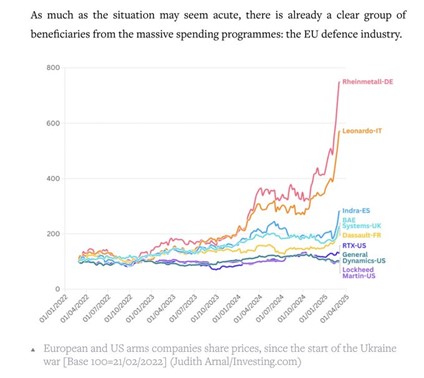
Germany creates an exception to its ‘fiscal brake’ for military expenditure
Over in Germany, the Chancellor-elect in the new coalition government, Friedrich Merz, pushed through the German parliament a law to end the so-called ‘fiscal brake’ that made it illegal for German governments to borrow beyond a strict limit or raise debt to pay for public spending. But now military deficit spending has priority above everything else, the only budget with no limit. The defence spending target will dwarf the deficit spending available for climate control and for badly needed infrastructure.
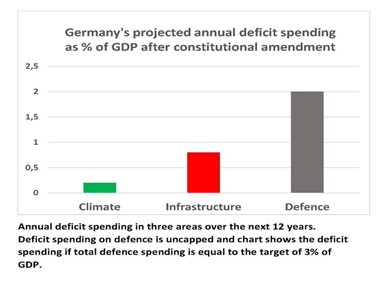
Annual government spending due to the new German fiscal package will be larger than the spending boom that came with the postwar Marshall Plan and with German reunification in the early 1990s.
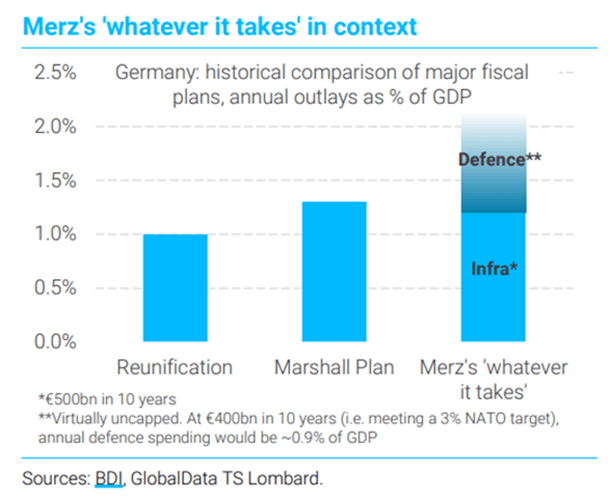
That brings me to the economic arguments for military spending. Can military expenditure kickstart an economy that is stuck in a depression, as much of Europe has been since the end of the Great Recession in 2009? Some Keynesians think so. German arms manufacturer Rheinmetall says that Volkswagen’s idle Osnabrück factory could be a prime candidate for conversion to military production. Keynesian economist, Matthew Klein, co-author with Michael Pettis of Trade Wars are Class Wars, greeted this news: “Germany is already building tanks. I am encouraging them to build many more tanks.”
The theory of ‘military Keynesianism’
The theory of ‘military Keynesianism’ has a history. One variant of this was the concept of the ‘permanent arms economy’ that was espoused by some Marxists to explain why the major economies did not go into a depression after the end of WW2, but instead entered a long boom with only mild recessions, that lasted until the 1974-5 international slump. This ‘golden age’ could only be explained, they said, by permanent military spending to keep up aggregate demand and sustain full employment.
But the evidence for this theory of the post-war boom is not there. UK government military spending fell from over 12% of GDP in 1952 to around 7% in 1960 and declined through the 1960s to reach about 5% by the end of the decade. And yet the British economy did better than at any time since. In all the advanced capitalist countries, defence spending was a substantially smaller fraction of total output by the end of the 1960s than in the early 1950s: from 10.2% of GDP in 1952-53 at the height of the Korean War; to only 6.5% by 1967. Yet economic growth was sustained pretty much through the 1960s and early 1970s.
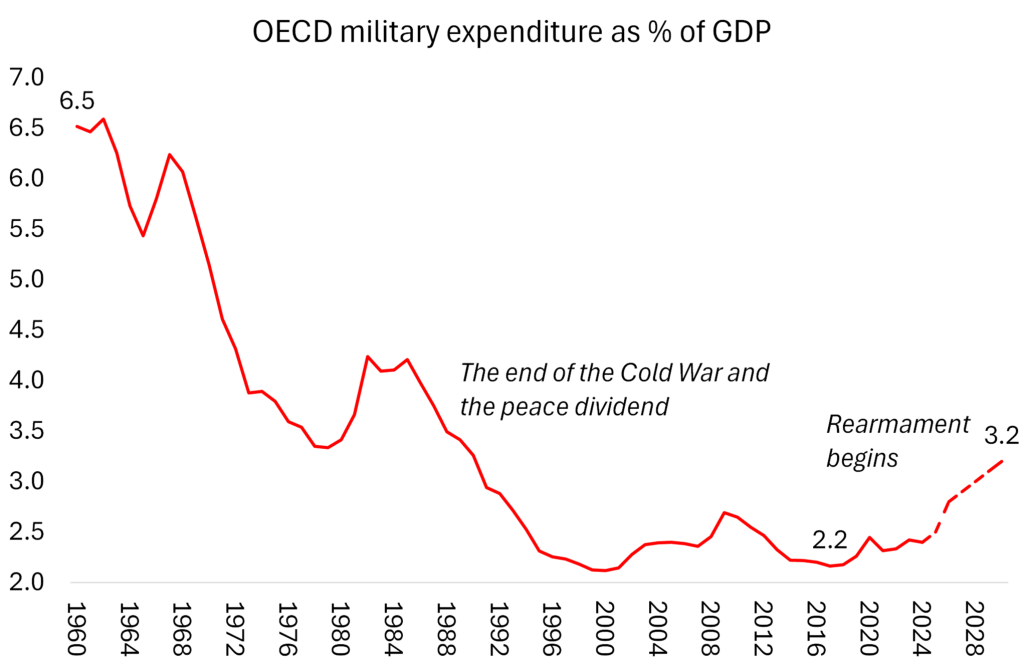
The post-war boom was not the result of Keynesian-style government spending on arms, but is explained by the post-war high rate of profitability on capital invested by the major economies. If anything, it was the other way around. Because the major economies were growing relatively fast and profitability was high, governments could afford to sustain military spending as part of their geopolitical ‘cold war’ objective to weaken and crush the Soviet Union – the then main enemy of imperialism.
Should Trades Unions welcome new jobs in an arms industry expansion?
Above all, military Keynesianism is against the interests of working people and humanity. Are we in favour of making arms to kill people in order to create jobs? This argument, often promoted by some trade union leaders, puts money before lives. Keynes once said: “The government should pay people to dig holes in the ground and then fill them up.” People would reply. “that’s stupid, why not pay people to build roads and schools.” Keynes would respond saying “Fine, pay them to build schools. The point is it doesn’t matter what they do as long as the government is creating jobs”.
Keynes was wrong. It does matter. Keynesianism advocates digging holes and filling them up to create jobs. Military Keynesianism advocates digging graves and filling them with bodies to create jobs. If it does not matter how jobs are created then why not dramatically increase tobacco production and promote the addiction to create jobs? Currently, most people would oppose this as being directly harmful to people’s health. Making weapons (conventional and unconventional) is also directly harmful. And there are plenty of other socially useful products and services that could deliver jobs and wages for workers (like schools and homes).
The UK government’s defence minister John Healey recently insisted that boosting the arms budget would “make our defence industry the driver of economic growth in this country”. Great news. Unfortunately for Healey, the UK’s arms industry’s trade association (ADS) estimates the UK has around 55,000 arms export jobs and another 115,00 employed in the Ministry of Defence. Even if you include the latter, that is only 0.5% of the UK workforce (see CAAT’s Arms to Renewables briefing for details). Even in the US, the ratio is much the same.
Do weapons have economic value in capitalism?
There is a theoretical question often at debate in Marxist political economy. It is whether the production of weapons is productive of value in a capitalist economy. The answer is that it is, for arms producers. The arms contractors deliver goods (weapons) which are paid for by the government. The labour producing them, therefore, is productive of value and surplus value. But at the level of the whole economy, arms production is unproductive of future value, in the same way that ‘luxury goods’ for just capitalist consumption are. Arms production and luxury goods do not re-enter the next production process, either as means of production or as means of subsistence for the working class. While being productive of surplus value for the arms capitalists, the production of weapons is not reproductive and thus threatens the reproduction of capital. So if the increase in the overall production of surplus value in an economy slows and the profitability of productive capital begins to fall, then reducing available surplus value for productive investment in order to invest in military spending can damage the ‘health’ of the capitalist accumulation process.
The outcome depends on the effect on the profitability of capital. The military sector generally has a higher organic composition of capital than the average in an economy as it incorporates leading-edge technologies. So the arms sector would tend to push down the average rate of profit. On the other hand, if taxes collected by the state (or cuts in civil spending) to pay for arms manufacture are high, then wealth that might otherwise go to labour can be distributed to capital and thus can add to available surplus value. Military expenditure may have a mildly positive effect on profit rates in arms-exporting countries but not for arms-importing ones. In the latter, spending on the military is a deduction from available profits for productive investment.
All-out war destroys ‘dead capital’
In the greater scheme of things, arms spending cannot be decisive for the health of the capitalist economy. On the other hand, all-out war can help capitalism out of depression and slump. It is a key argument of Marxist economics (at least in my version) that capitalist economies can only recover in a sustained way if average profitability for the productive sectors of the economy rises significantly. And that would require sufficient destruction in the value of ‘dead capital’ (past accumulation) that is no longer profitable to employ.
The Great Depression of the 1930s in the US economy lasted so long because profitability did not recover throughout that decade. In 1938, the US corporate rate of profit was still less than half the rate of 1929. Profitability only picked up once the war economy was underway, by 1940 onwards.
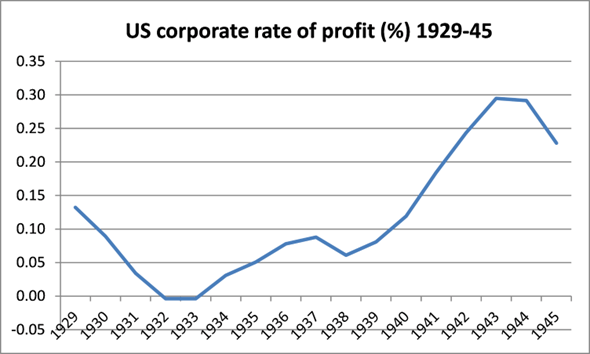
The US state sector dominated investment during WW2
So it was not ‘military Keynesianism’ that took the US economy out of the Great Depression – as some Keynesians like to think. US economic recovery from the Great Depression did not start until the world war was underway. Investment took off only from 1941 (Pearl Harbor) onwards to reach, as a share of GDP, more than double the level that investment stood at in 1940. Why was that? Well, it was not the result of a pick-up in private sector investment. What happened was a massive rise in government investment and spending. In 1940, private sector investment was still below the level of 1929 and actually fell further during the war. The state sector took over nearly all investment, as resources (value) were diverted to the production of arms and other security measures in a full war economy.
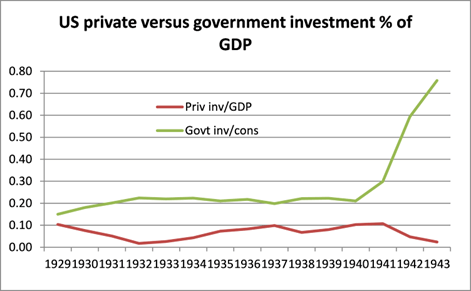
But is not increased government investment and consumption a form of Keynesian stimulus, but just at a higher level? Well, no. The difference is revealed in the continued collapse of consumption. The war economy was paid for by restricting the opportunities for workers to spend their incomes from their war-time jobs. There was forced saving through the purchase of war bonds, rationing and increased taxation to pay for the war. Government investment meant the direction and planning of production by government decree. The war economy did not stimulate the private sector, it replaced the ‘free market’ and capitalist investment for profit. Consumption did not restore economic growth as Keynesians (and those who see the cause of crisis in under-consumption) would expect; instead it was investment in mainly weapons of mass destruction.
The special conditions created by war
The war decisively ended the depression. American industry was revitalized by the war and many sectors were oriented to defence production (for example, aerospace and electronics) or completely dependent on it (atomic energy). The war’s rapid scientific and technological changes continued and intensified trends begun during the Great Depression. As the war severely damaged every major economy in the world except for the US, American capitalism gained economic and political hegemony after 1945.
Guiglelmo Carchedi explained: “Why did the war bring about such a jump in profitability in the 1940‐5 period? The denominator of the rate not only did not rise, but dropped because the physical depreciation of the means of production was greater than new investments. At the same time, unemployment practically disappeared. Decreasing unemployment made higher wages possible. But higher wages did not dent profitability. In fact, the conversion of civilian into military industries reduced the supply of civilian goods. Higher wages and the limited production of consumer goods meant that labour’s purchasing power had to be greatly compressed in order to avoid inflation. This was achieved by instituting the first general income tax, discouraging consumer spending (consumer credit was prohibited) and stimulating consumer saving, principally through investment in war bonds. Consequently, labour was forced to postpone the expenditure of a sizeable portion of wages. At the same time labour’s rate of exploitation increased. In essence, the war effort was a labour‐financed massive production of means of destruction.”
Let Keynes sum it up: “It is, it seems, politically impossible for a capitalistic democracy to organize expenditure on the scale necessary to make the grand experiments which would prove my case — except in war conditions,” from The New Republic (quoted from P. Renshaw, Journal of Contemporary History 1999 vol. 34 (3) p. 377 -364).
From the blog of Michael Roberts. The original, with all charts and hyperlinks, can be found here.
 From welfare to warfare: military Keynesianism - By Michael Roberts Warmongering has reached fever pitch in Europe. It all started with the US under Trump deciding that paying for the military ‘protection’
From welfare to warfare: military Keynesianism - By Michael Roberts Warmongering has reached fever pitch in Europe. It all started with the US under Trump deciding that paying for the military ‘protection’ Thinking Systematics - By Michael Roberts Canadian Marxist sociologists Murray EG Smith and Tim Hayslip have written a profound and wide-ranging book that aims to elaborate and popularize
Thinking Systematics - By Michael Roberts Canadian Marxist sociologists Murray EG Smith and Tim Hayslip have written a profound and wide-ranging book that aims to elaborate and popularize Ukraine war: is it a proxy war, and was Russia provoked? - By John Pickard There are differences of opinion on the left of the British labour movement on the attitude that socialists should adopt towards the
Ukraine war: is it a proxy war, and was Russia provoked? - By John Pickard There are differences of opinion on the left of the British labour movement on the attitude that socialists should adopt towards the The Russian Revolution of 1905 - This months marks 120 years since the outbreak of revolution in Tsarist Russia. It actually began on January 9 1905, but, as this article shows,
The Russian Revolution of 1905 - This months marks 120 years since the outbreak of revolution in Tsarist Russia. It actually began on January 9 1905, but, as this article shows, The historical roots of Stalinism - By Greg Oxley Continuing our regular series of articles on theoretical issues, here Greg Oxley editor of the French Marxist website La Riposte, explains the
The historical roots of Stalinism - By Greg Oxley Continuing our regular series of articles on theoretical issues, here Greg Oxley editor of the French Marxist website La Riposte, explains the

